Tracking Biofuel Innovation: A Graph-Based Analysis of Sustainable Aviation Fuel Patents
Abstract
1. Introduction
2. Literature Review
2.1. Advances in Visualizing and Understanding Graphs and Complex Patent Networks
Degree Centrality
- is the degree centrality,
- is the degree of node v,
- v* is the vertex with the highest degree,
- .
2.2. A Synthesis of Feedstocks and Production Pathways
3. Materials and Methods
3.1. Data Collection
3.2. Data Retrieval and Preprocessing
- Patent Information Parsing: Patent documents were processed, with critical data elements extracted using processes such as patent assignees, international patent classification (IPC) codes, filing application dates, and patent families’ IDs. Table 3 also shows the renaming table.
- Data Filtering: A segregation approach was implemented to separate actual patent families from the exclusively “WO” applications (entries with no IDs other than those with the prefix).
- Data Manipulation: The patent assignee’s leading company was extracted from the field to aggregate companies that belong to the same organization; family size was created by the count of the individual patent numbers, excluding “WO” applications; patent year was extracted from the “Application Details and Date” field; and a column “Years until expiration” was created for patents (20 years from 14 May 2024) and “WO” applications (2.5 years from 14 May 2024).
3.3. Graph Generation
3.3.1. IPC–Assignee Network
3.3.2. IPC–Patent-Assignee Network
3.3.3. IPC–Assignee–Written Opinion Network
3.4. Python Libraries and Tools for Graph Analysis
- Pandas: Implemented for data management and processing.
- NetworkX: Employed to create graph structures and for graphics analysis.
- PyVis: Used to create the NetworkX graph as an HTML file for interactive analysis.
4. Analysis and Results
4.1. Contextualizing SAF Patent Data
4.2. SAF Complex Network Analysis
5. Conclusions
Author Contributions
Funding
Data Availability Statement
Acknowledgments
Conflicts of Interest
References
- Akpan, J.; Olanrewaju, O. Sustainable Energy Development: History and Recent Advances. Energies 2023, 16, 7049. [Google Scholar] [CrossRef]
- Wang, F.; Harindintwali, J.D.; Yuan, Z.; Wang, M.; Wang, F.; Li, S.; Yin, Z.; Huang, L.; Fu, Y.; Li, L.; et al. Technologies and perspectives for achieving carbon neutrality. Innovation 2021, 2, 100180. [Google Scholar] [CrossRef]
- Caldeira, A.A.; Wilbert, M.D.; Moreira, T.B.S.; Serrano, A.L.M. Brazilian State debt sustainability: An analysis of net debt and primary balance; [Sustainability of Brazilian state debt: An analysis of the relationship between net debt and primary result]; [Sustainability of the debt of the Brazilian states: An analysis of the net debt and the primary balance]. Public Adm. Mag. 2016, 50, 285–306. [Google Scholar] [CrossRef]
- Ray, P. Renewable energy and sustainability. Clean Technol. Environ. Policy 2019, 21, 1517–1533. [Google Scholar] [CrossRef]
- Bustamante, M.M.; Silva, J.S.; Scariot, A.; Sampaio, A.B.; Mascia, D.L.; Garcia, E.; Sano, E.; Fernandes, G.W.; Durigan, G.; Roitman, I.; et al. Ecological restoration as a strategy for mitigating and adapting to climate change: Lessons and challenges from Brazil. Mitig. Adapt. Strateg. Glob. Chang. 2019, 24, 1249–1270. [Google Scholar] [CrossRef]
- Cucchiella, F.; Condemi, A.; Rotilio, M.; Annibaldi, V. Energy Transitions in Western European Countries: Regulation Comparative Analysis. Energies 2021, 14, 3940. [Google Scholar] [CrossRef]
- Chou, C.H.; Ngo, S.L.; Tran, P.P. Renewable Energy Integration for Sustainable Economic Growth: Insights and Challenges via Bibliometric Analysis. Sustainability 2023, 15, 15030. [Google Scholar] [CrossRef]
- Kullmann, F.; Markewitz, P.; Stolten, D.; Robinius, M. Combining the worlds of energy systems and material flow analysis: A review. Energy Sustain. Soc. 2021, 11, 13. [Google Scholar] [CrossRef]
- Stergiou, E.; Rigas, N.; Zaroutieri, E.; Kounetas, K. Energy, renewable and technical efficiency convergence: A global evidence. Econ. Chang. Restruct. 2023, 56, 1601–1628. [Google Scholar] [CrossRef]
- Cabrera, E.; de Sousa, J.M.M. Use of Sustainable Fuels in Aviation—A Review. Energies 2022, 15, 2440. [Google Scholar] [CrossRef]
- Abrantes, I.; Ferreira, A.F.; Silva, A.; Costa, M. Sustainable aviation fuels and imminent technologies—CO2 emissions evolution towards 2050. J. Clean. Prod. 2021, 313, 127937. [Google Scholar] [CrossRef]
- Yusaf, T.; Fernandes, L.; Abu Talib, A.R.; Altarazi, Y.S.M.; Alrefae, W.; Kadirgama, K.; Ramasamy, D.; Jayasuriya, A.; Brown, G.; Mamat, R.; et al. Sustainable Aviation—Hydrogen Is the Future. Sustainability 2022, 14, 548. [Google Scholar] [CrossRef]
- Gray, N.; McDonagh, S.; O’Shea, R.; Smyth, B.; Murphy, J.D. Decarbonising ships, planes and trucks: An analysis of suitable low-carbon fuels for the maritime, aviation and haulage sectors. Adv. Appl. Energy 2021, 1, 100008. [Google Scholar] [CrossRef]
- Henning, M.A.; van Vuuren, J.H. Eulerian graphs. In Graph and Network Theory: An Applied Approach Using Mathematica®; Springer: Cham, Switzerland, 2022; pp. 293–322. [Google Scholar]
- Qin, Z.; Zhang, H.; Qin, X.; Xu, K.; Dimitrov, K.N.A.; Wang, G.; Yu, W.; Qin, Z.; Zhang, H.; Qin, X.; et al. The history of computing. In Fundamentals of Software Culture; Springer: Singapore, 2018; pp. 1–36. [Google Scholar]
- Gan, W.; Sun, Y.; Sun, Y. Knowledge structure enhanced graph representation learning model for attentive knowledge tracing. Int. J. Intell. Syst. 2022, 37, 2012–2045. [Google Scholar] [CrossRef]
- Adadi, A. A survey on data-efficient algorithms in big data era. J. Big Data 2021, 8, 24. [Google Scholar] [CrossRef]
- Gross, J.L.; Yellen, J. Graph Theory and Its Applications; Chapman and Hall/CRC: Boca Raton, FL, USA, 2019. [Google Scholar]
- Ma, D.; Yu, Q.; Li, J.; Ge, M. Innovation diffusion enabler or barrier: An investigation of international patenting based on temporal exponential random graph models. Technol. Soc. 2021, 64, 101456. [Google Scholar] [CrossRef]
- Yang, W.; Yu, X.; Zhang, B.; Huang, Z. Mapping the landscape of international technology diffusion (1994–2017): Network analysis of transnational patents. J. Technol. Transf. 2021, 46, 138–171. [Google Scholar] [CrossRef]
- Bispo, G.D.; Vergara, G.F.; Saiki, G.M.; Martins, P.H.d.S.; Coelho, J.G.; Rodrigues, G.A.P.; Oliveira, M.N.d.; Mosquéra, L.R.; Gonçalves, V.P.; Neumann, C.; et al. Automatic Literature Mapping Selection: Classification of Papers on Industry Productivity. Appl. Sci. 2024, 14, 3679. [Google Scholar] [CrossRef]
- Maskittou, M.; El Haddadi, A.; Routaib, H. Feature Learning of Patent Networks Using Tensor Decomposition. In Innovations in Smart Cities Applications Volume 4: The Proceedings of the 5th International Conference on Smart City Applications; Springer: Cham, Switzerland, 2021; pp. 1375–1390. [Google Scholar]
- Wang, Y.; Richard, R.; McDonald, D. Competitive analysis with graph embedding on patent networks. In Proceedings of the 2020 IEEE 22nd Conference on Business Informatics (CBI), Antwerp, Belgium, 22–24 June 2020; Volume 1, pp. 10–19. [Google Scholar]
- Ding, W.; Wang, J.; Zhu, H. Using graph representations for semantic information extraction from chinese patents. In Proceedings of the 2019 3rd International Symposium on Computer Science and Intelligent Control, New York, NY, USA, 25–27 September 2019; pp. 1–5. [Google Scholar]
- Björkqvist, S.; Kallio, J. Building a graph-based patent search engine. In Proceedings of the 46th International ACM SIGIR Conference on Research and Development in Information Retrieval, Taipei, Taiwan, 23–27 July 2023; pp. 3300–3304. [Google Scholar]
- Liu, W.; Zhang, H.; Guo, X.; Han, Y. Graph Convolutional Network Based Patent Issue Discovery Model. In Proceedings of the 2021 International Joint Conference on Neural Networks (IJCNN), Virtual, 18–22 July 2021; pp. 1–8. [Google Scholar]
- Trappey, A.J.; Trappey, C.V.; Liang, C.P.; Lin, H.J. IP Analytics and Machine Learning Applied to Create Process Visualization Graphs for Chemical Utility Patents. Processes 2021, 9, 1342. [Google Scholar] [CrossRef]
- Jun, S. Patent Big Data Analysis using Graph Theory. Adv. Sci. Technol. Lett. 2015, 85, 25–28. [Google Scholar]
- Lee, J.; Lee, J.; Kang, J.H.; Park, S.; Jun, S.; Jang, D. A Study on Visualization of Technology Transfer using Distance based Patent Network Analysis. In Proceedings of the 9th International Conference on Information Communication and Management, Prague, Czech Republic, 23–26 August 2019; pp. 66–69. [Google Scholar]
- Yan, B.; Luo, J. Filtering patent maps for visualization of diversification paths of inventors and organizations. J. Assoc. Inf. Sci. Technol. 2017, 68, 1551–1563. [Google Scholar] [CrossRef]
- Kay, L.; Porter, A.L.; Youtie, J.; Newman, N.; Ràfols, I. Visual analysis of patent data through global maps and overlays. In Current Challenges in Patent Information Retrieval; Springer: Berlin/Heidelberg, Germany, 2017; pp. 281–295. [Google Scholar]
- Rodriguez, A.; Kim, B.; Turkoz, M.; Lee, J.M.; Coh, B.Y.; Jeong, M.K. New multi-stage similarity measure for calculation of pairwise patent similarity in a patent citation network. Scientometrics 2015, 103, 565–581. [Google Scholar] [CrossRef]
- Leavitt, H. Some Effects of Certain Communication Patterns on Group Performance. J. Abnorm. Soc. Psychol. 1951, 46, 38–50. [Google Scholar] [CrossRef]
- Freeman, L.C.; Roeder, D.; Mulholland, R.R. Centrality in social networks: II. experimental results. Soc. Netw. 1979, 2, 119–141. [Google Scholar] [CrossRef]
- Freeman, L.C. Centrality in social networks conceptual clarification. Soc. Netw. 1978, 1, 215–239. [Google Scholar] [CrossRef]
- Metcalf, L.; Casey, W. Chapter 5—Graph theory. In Cybersecurity and Applied Mathematics; Metcalf, L., Casey, W., Eds.; Syngress: Boston, MA, USA, 2016; pp. 67–94. [Google Scholar] [CrossRef]
- Everett, M.G.; Borgatti, S.P. The centrality of groups and classes. J. Math. Sociol. 1999, 23, 181–201. [Google Scholar] [CrossRef]
- Mahmood, A.R.; Abdullah, M.R.; Khalaf, H.S. Biofuel Production and Its Impact on Global Food Security: A Review Article. Iraqi J. Ind. Res. 2022, 9, 75–83. [Google Scholar] [CrossRef]
- Jamwal, V.L.; Kapoor, N.; Gandhi, S.G. Biotechnology of biofuels: Historical overview, business outlook and future perspectives. In Biotechnology Business-Concept to Delivery; Springer: Cham, Switzerland, 2020; pp. 109–127. [Google Scholar]
- Sultana, S.; Nur, A.A.; Khan, S.; Ambati, R.R.; Gokare Aswathanarayana, R. Biofuels as Economic Security for the Poor. In Biofuels in Circular Economy; Springer: Singapore, 2023; pp. 201–218. [Google Scholar]
- Eswaran, N.; Parameswaran, S.; Johnson, T. Biofuels and sustainability. In Biofuels and Biodiesel; Humana: New York, NY, USA, 2021; pp. 317–342. [Google Scholar]
- Ng, K.S.; Farooq, D.; Yang, A. Global biorenewable development strategies for sustainable aviation fuel production. Renew. Sustain. Energy Rev. 2021, 150, 111502. [Google Scholar] [CrossRef]
- United State’s Department of Energy. Alternative Fuels Data Center-Sustainable Aviation Fuel. 2023. Available online: https://afdc.energy.gov/fuels/sustainable-aviation-fuel (accessed on 16 May 2024).
- Qasem, N.A.; Mourad, A.; Abderrahmane, A.; Said, Z.; Younis, O.; Guedri, K.; Kolsi, L. A recent review of aviation fuels and sustainable aviation fuels. J. Therm. Anal. Calorim. 2024, 149, 4287–4312. [Google Scholar] [CrossRef]
- Antar, M.; Lyu, D.; Nazari, M.; Shah, A.; Zhou, X.; Smith, D.L. Biomass for a sustainable bioeconomy: An overview of world biomass production and utilization. Renew. Sustain. Energy Rev. 2021, 139, 110691. [Google Scholar] [CrossRef]
- Prabhansu; Kumar, N. Biomass as Emerging Renewable: Challenges and Opportunities. In Renewable Energy for Sustainable Growth Assessment; John Wiley & Sons, Ltd.: Hoboken, NJ, USA, 2022; Chapter 1; pp. 1–23. [Google Scholar] [CrossRef]
- Barot, S. Biomass and Bioenergy: Resources, Conversion and Application. In Renewable Energy for Sustainable Growth Assessment; John Wiley & Sons, Ltd.: Hoboken, NJ, USA, 2022; Chapter 9; pp. 243–262. [Google Scholar] [CrossRef]
- Malla, F.A.; Bandh, S.A.; Wani, S.A.; Hoang, A.T.; Sofi, N.A. Biofuels: Potential Alternatives to Fossil Fuels. In Biofuels in Circular Economy; Bandh, S.A., Malla, F.A., Eds.; Springer Books; Springer: Singapore, 2022; pp. 1–15. [Google Scholar] [CrossRef]
- Carpanez, T.; Moreira, V.; Assis, I.; Amaral, M. Sugarcane vinasse as organo-mineral fertilizers feedstock: Opportunities and environmental risks. Sci. Total Environ. 2022, 832, 154998. [Google Scholar] [CrossRef]
- Sundaram, T.; Rajendran, S.; Gnanasekaran, L.; Rachmadona, N.; Jiang, J.J.; Khoo, K.S.; Show, P.L. Bioengineering strategies of microalgae biomass for biofuel production: Recent advancement and insight. Bioengineered 2023, 14, 2252228. [Google Scholar] [CrossRef] [PubMed]
- Widyati, E.; Nuroniah, H.S.; Tata, H.L.; Mindawati, N.; Lisnawati, Y.; Darwo; Abdulah, L.; Lelana, N.E.; Mawazin.; Octavia, D.; et al. Soil Degradation Due to Conversion from Natural to Plantation Forests in Indonesia. Forests 2022, 13, 1913. [Google Scholar] [CrossRef]
- Kandaramath Hari, T.; Yaakob, Z.; Binitha, N.N. Aviation biofuel from renewable resources: Routes, opportunities and challenges. Renew. Sustain. Energy Rev. 2015, 42, 1234–1244. [Google Scholar] [CrossRef]
- Ângelo, H.; De Almeida, A.N.; Serrano, A.L.M. Determinants of Brazil’s demand of pulpwood; [Determinantes da demanda de madeira em toras para celulose no Brasil]. Sci. For. Sci. 2009, 37, 491–498. [Google Scholar]
- Shehab, M.; Moshammer, K.; Franke, M.; Zondervan, E. Analysis of the Potential of Meeting the EU’s Sustainable Aviation Fuel Targets in 2030 and 2050. Sustainability 2023, 15, 9266. [Google Scholar] [CrossRef]
- Tomar, M.; Abraham, A.; Kim, K.; Mayhew, E.; Lee, T.; Brezinsky, K.; Lynch, P. Bio-derived sustainable aviation fuels—On the verge of powering our future. In Combustion Chemistry and the Carbon Neutral Future; Elsevier: Amsterdam, The Netherlands, 2023; pp. 521–598. [Google Scholar]
- Mäki-Arvela, P.; Aho, A.; Simakova, I.; Yu. Murzin, D. Sustainable Aviation Fuel from Syngas through Higher Alcohols. ChemCatChem 2022, 14, e202201005. [Google Scholar] [CrossRef]
- Detsios, N.; Theodoraki, S.; Maragoudaki, L.; Atsonios, K.; Grammelis, P.; Orfanoudakis, N.G. Recent advances on alternative aviation fuels/pathways: A critical review. Energies 2023, 16, 1904. [Google Scholar] [CrossRef]
- Deuber, R.d.S.; Bressanin, J.M.; Fernandes, D.S.; Guimarães, H.R.; Chagas, M.F.; Bonomi, A.; Fregolente, L.V.; Watanabe, M.D.B. Production of Sustainable Aviation Fuels from Lignocellulosic Residues in Brazil through Hydrothermal Liquefaction: Techno-Economic and Environmental Assessments. Energies 2023, 16, 2723. [Google Scholar] [CrossRef]
- Lai, Y.Y.; Karakaya, E.; Björklund, A. Employing a socio-technical system approach in prospective life cycle assessment: A case of large-scale Swedish sustainable aviation fuels. Front. Sustain. 2022, 3, 912676. [Google Scholar] [CrossRef]
- Liu, S. Development Prospect of Sustainable Aviation Fuel. In Annual Report on China’s Petroleum, Gas and New Energy Industry (2021); Springer: Singapore, 2022; pp. 265–276. [Google Scholar]
- Seçilmiş, N. Sustainable Aviation Based on Innovation. In Corporate Governance, Sustainability, and Information Systems in the Aviation Sector, Volume I; Springer: Singapore, 2022; pp. 93–119. [Google Scholar]
- Korkut, E.; Fowler, L.B. Regulatory and policy analysis of production, development and use of sustainable aviation fuels in the United States. Front. Energy Res. 2021, 9, 750514. [Google Scholar] [CrossRef]
- World Intellectual Property Organization. Patent Cooperation Treaty (PCT). 2022. Available online: https://www.wipo.int/export/sites/www/pct/en/docs/texts/ai.pdf (accessed on 12 May 2024).
- González-Cobos, J.; Prévot, M.S.; Vernoux, P. Electrolysis of lignin for production of chemicals and hydrogen. Curr. Opin. Electrochem. 2023, 39, 101255. [Google Scholar] [CrossRef]
- Zhu, M.; Ge, Q.; Zhu, X. Catalytic reduction of CO2 to CO via reverse water gas shift reaction: Recent advances in the design of active and selective supported metal catalysts. Trans. Tianjin Univ. 2020, 26, 172–187. [Google Scholar] [CrossRef]
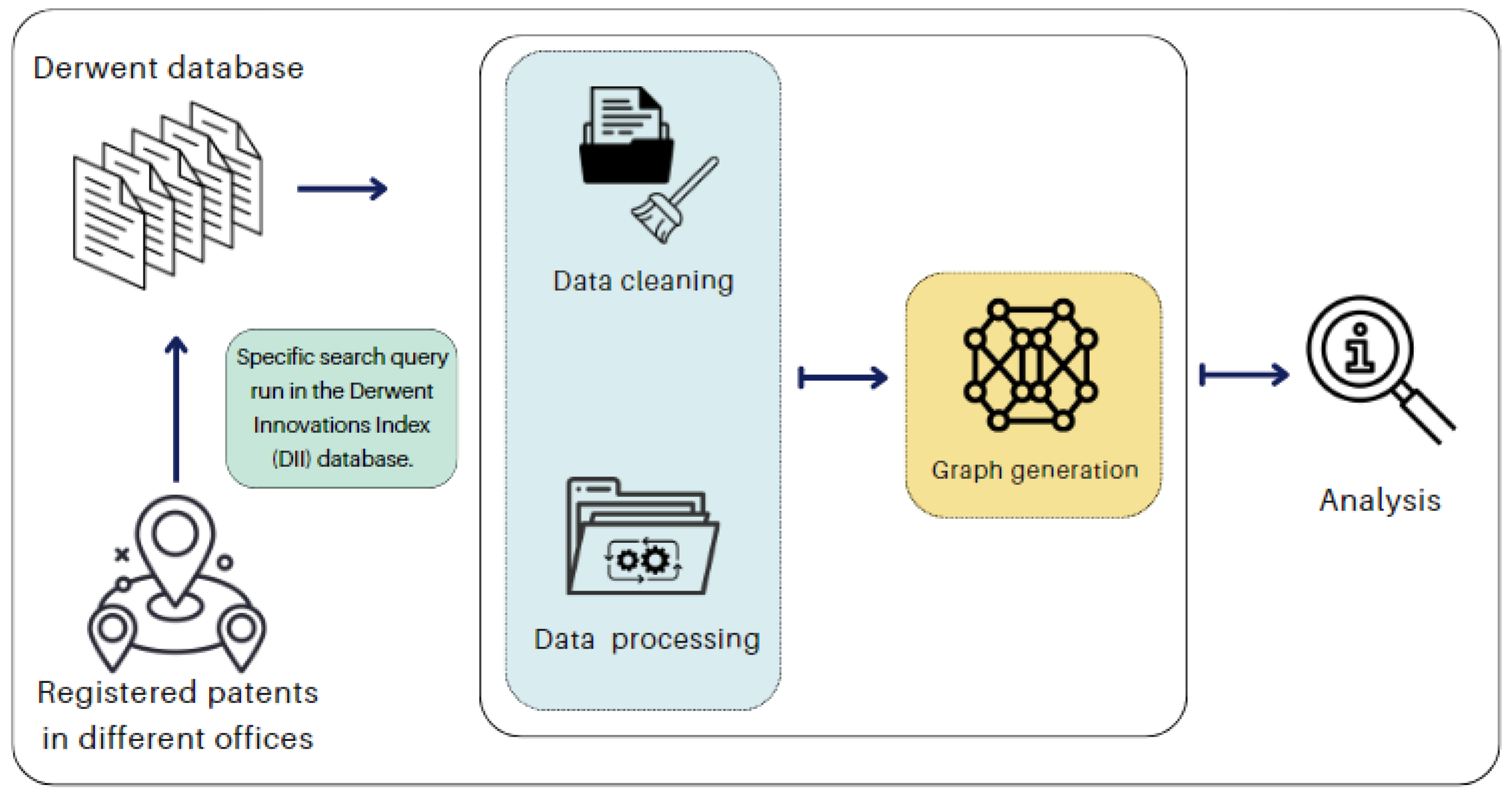

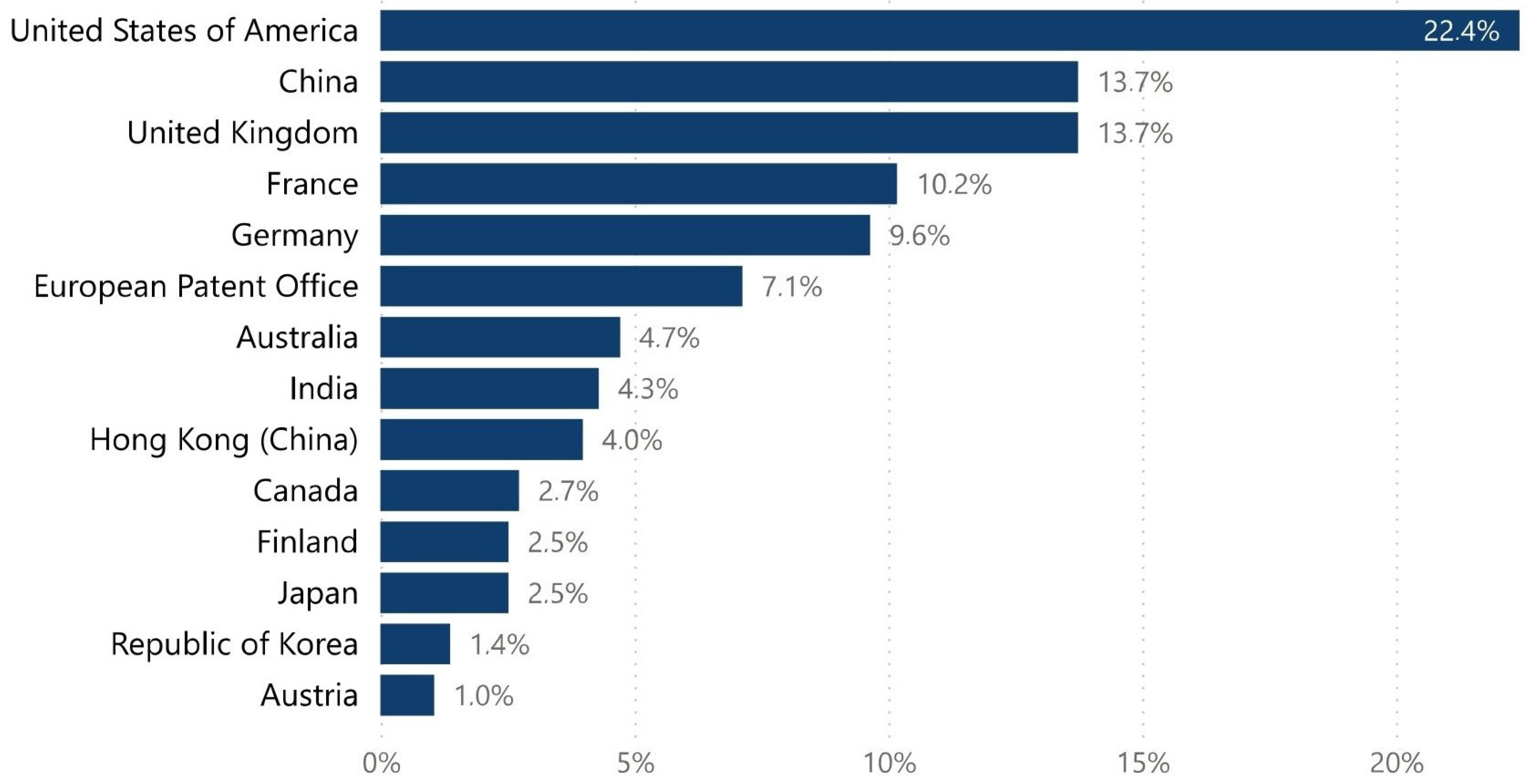

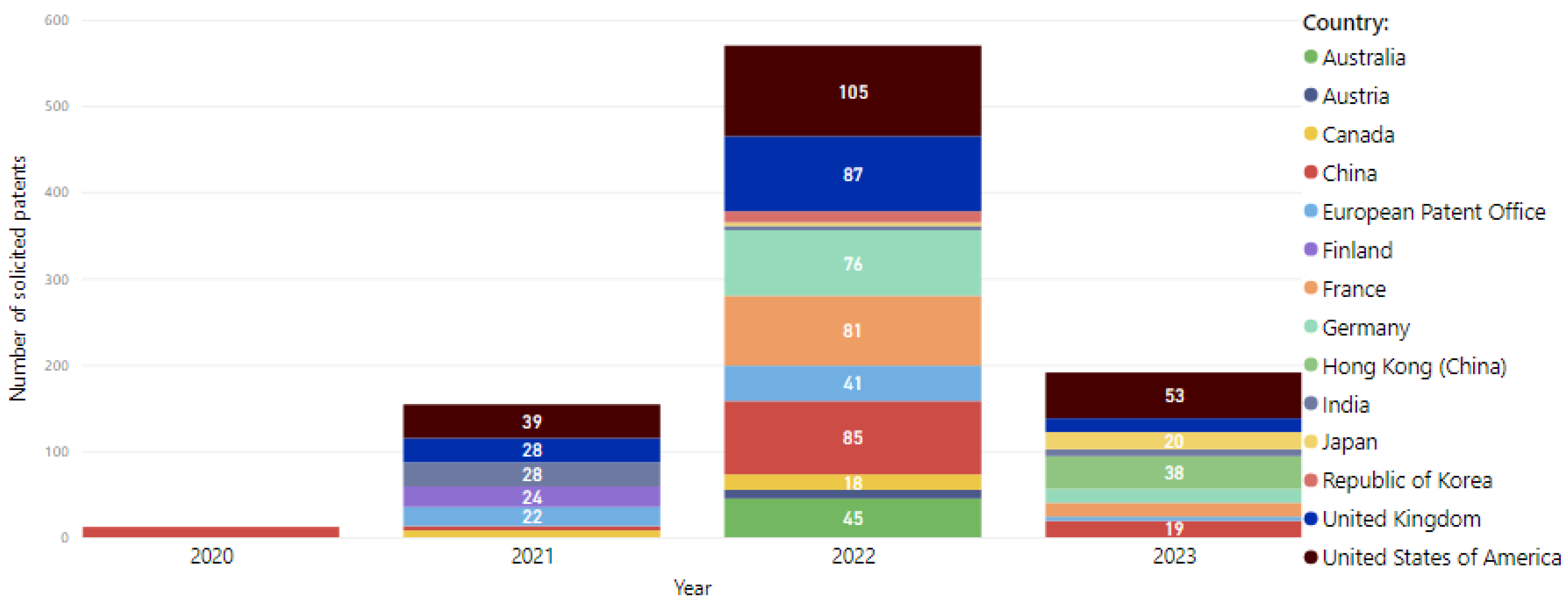


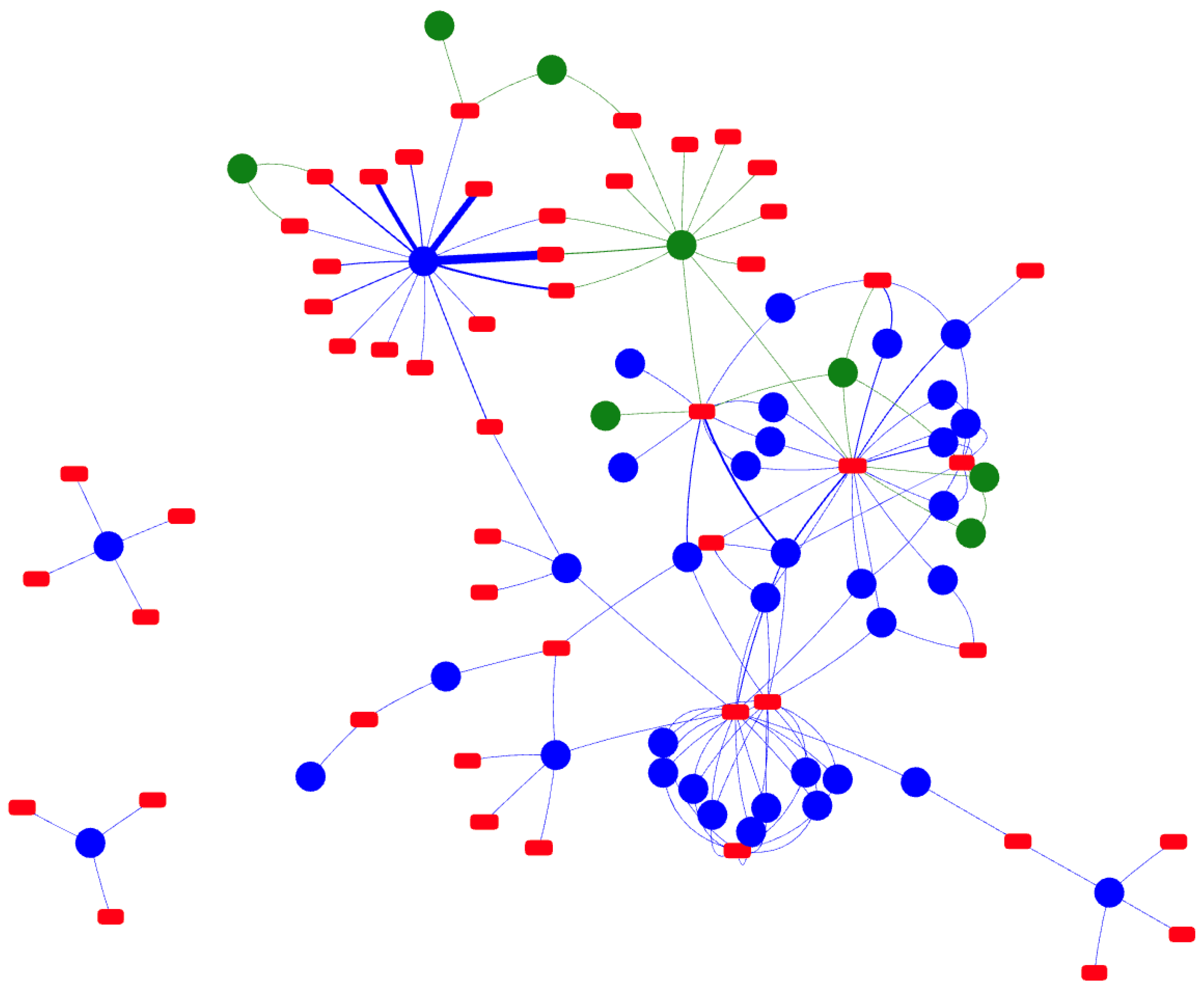

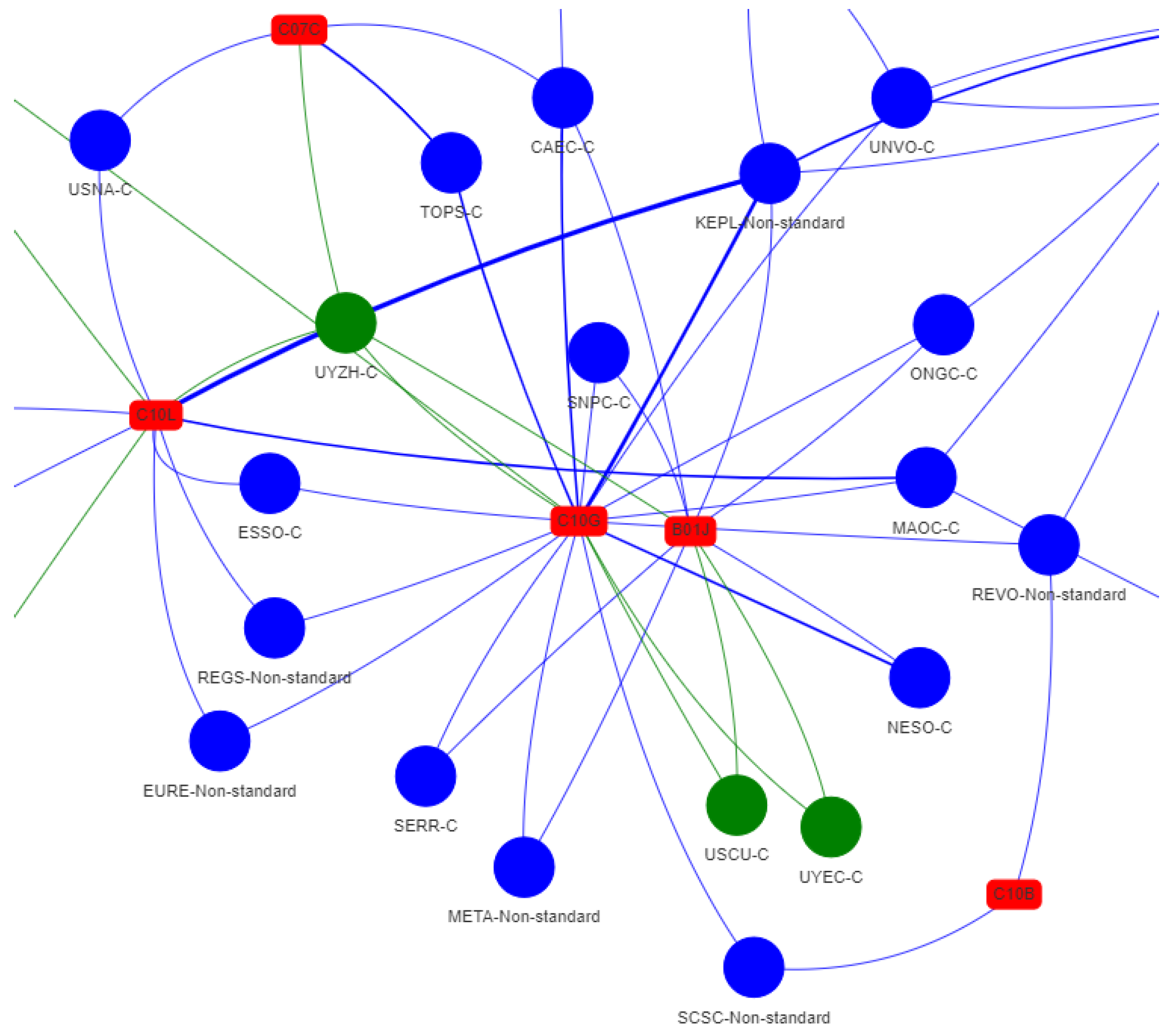
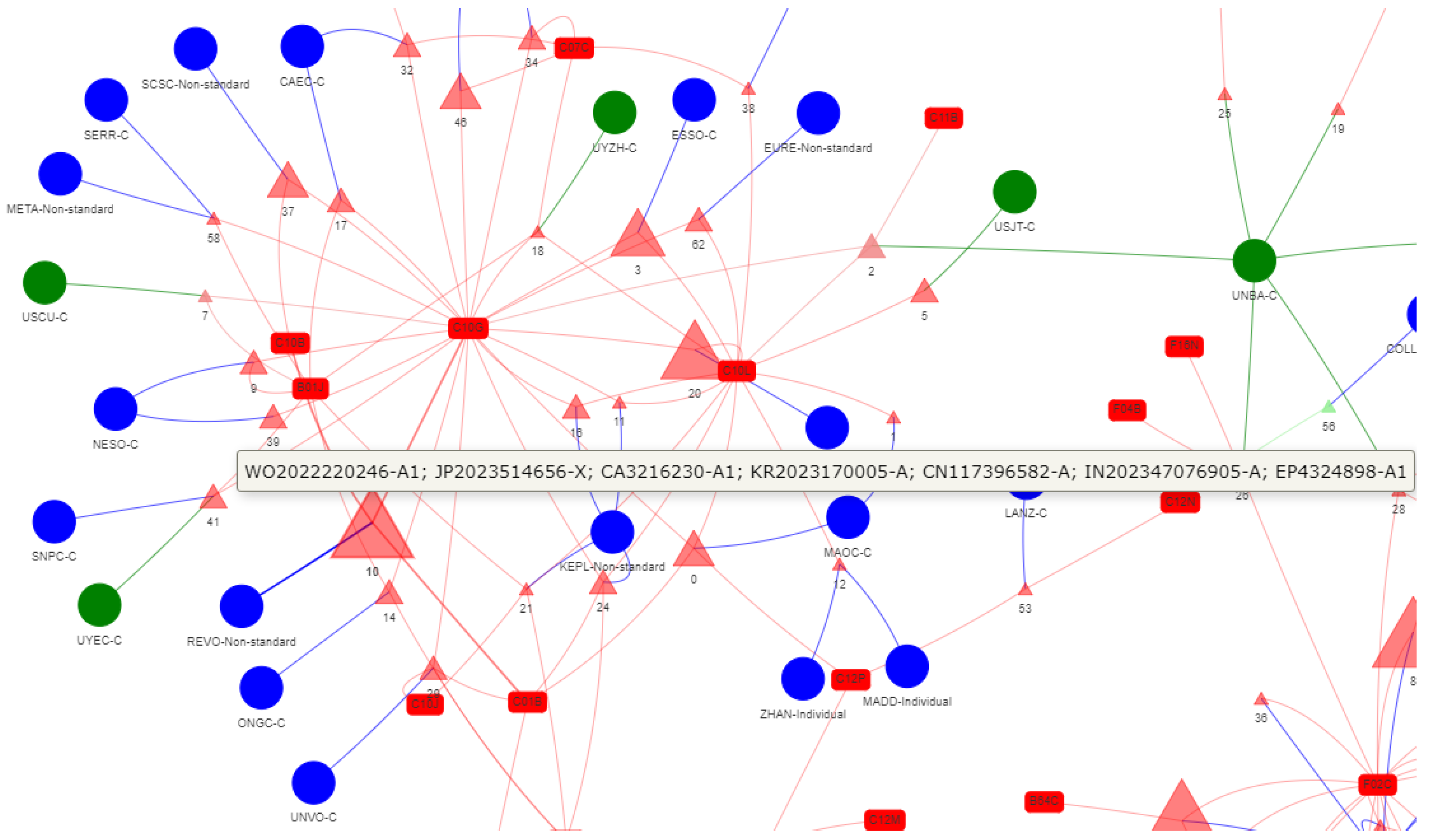
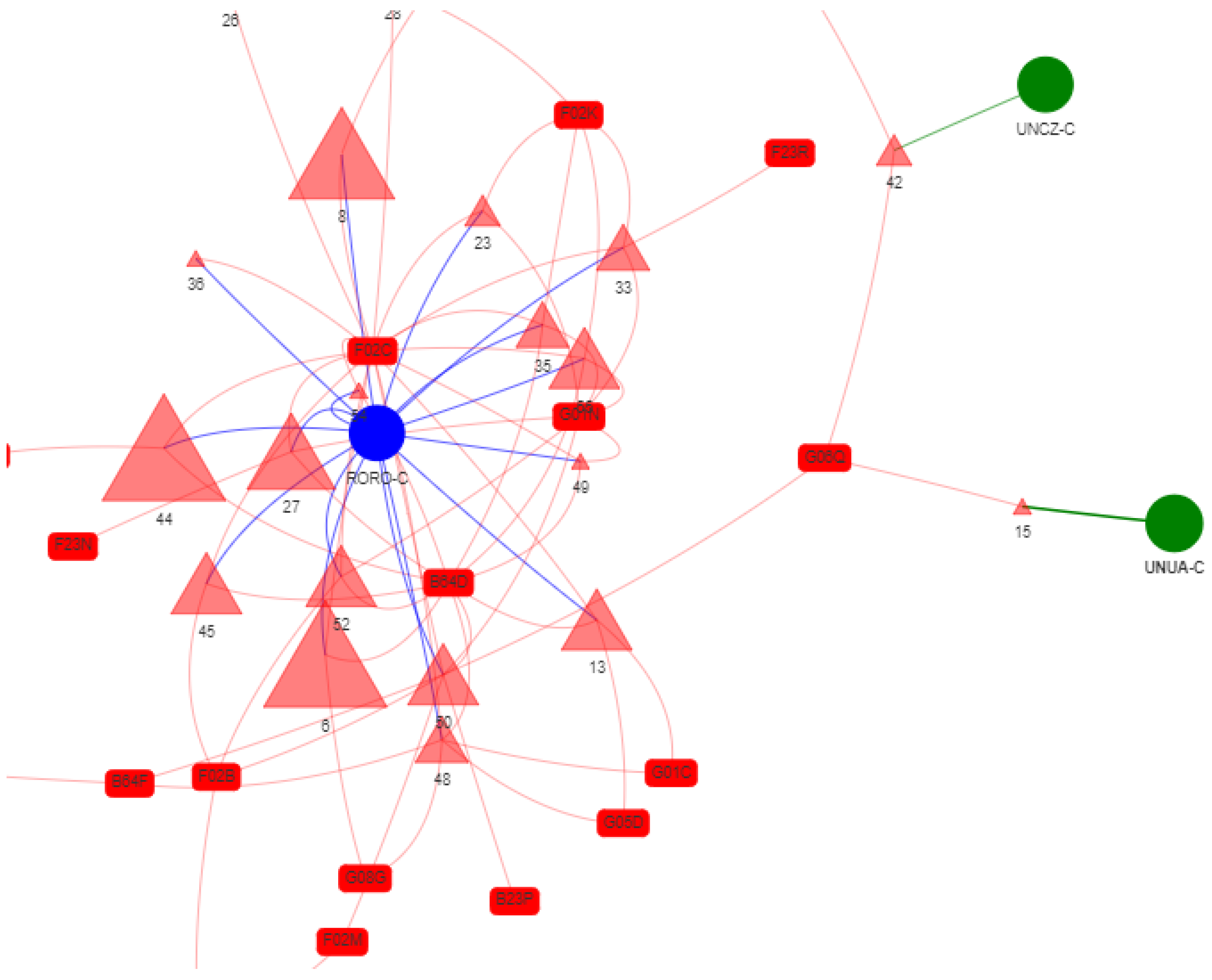
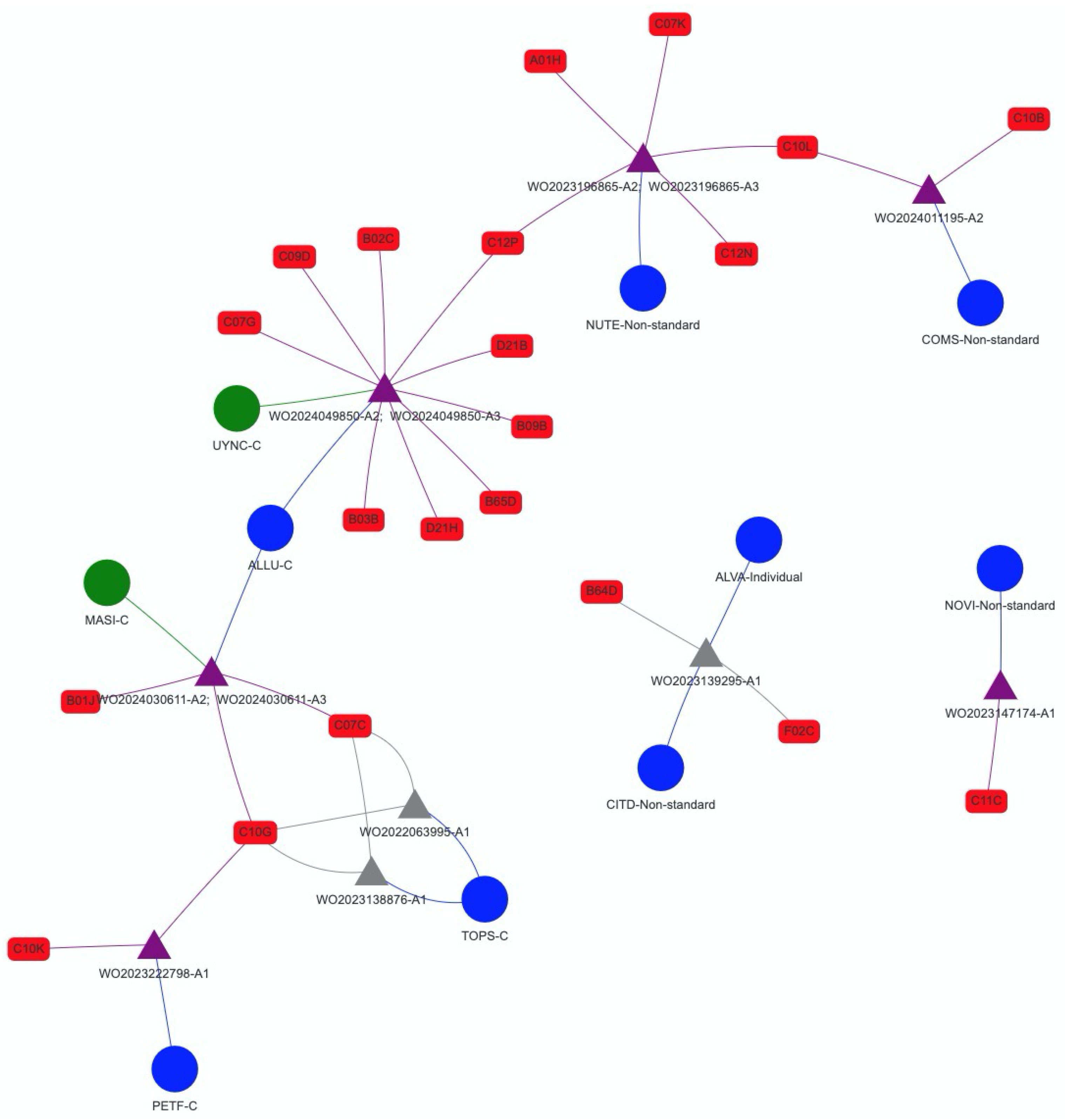


| Ref. | Year | Advantages | Limitations |
|---|---|---|---|
| [18] | 2019 | Provides a foundational understanding of graph theory and its applications in various fields | Not specifically focused on graph theory-based patent analysis |
| [19] | 2021 | Offers a graph-theoretic method for visualizing and analyzing patents | Estimation intensive to model specification, potentially affecting the robustness of the results |
| [20] | 2021 | Identifies transnational patents at the national level to depict the profiles of international technology diffusion | Difficulty tracking development trends in different technologies |
| [22] | 2021 | Enables creation of patent networks using clustering algorithms, providing insights into connections between patents and companies | Difficulty extracting relevant information from technical patents |
| [23] | 2020 | Uses graph embedding techniques to understand competitive dynamics between firms through patent networks | Rapid growth of patent data (big data) makes analysis complex |
| [24] | 2019 | Proposes graph representation strategies for automatic semantic data extraction from patents, aiding intelligent patent analysis | Existing methods like text mining and keyword analysis for patent similarity have limitations |
| [25] | 2023 | Efficiently searches technical documents and mimics work of professional patent examiners | Requires domain knowledge to analyze documents |
| [26] | 2021 | Identifies and tags “issue sentences” (problems addressed by patents) | Complexity of understanding technical patents |
| [27] | 2021 | Uses text mining and machine learning to automatically extract and visualize chemical processes from patents | Rapid growth of patent data (big data) |
| [28] | 2015 | Proposes a graph model for visualizing patent data | Limitations of existing approaches like text mining and keyword analysis for patent similarity |
| [29] | 2019 | Visualizes patent portfolio strategies and aids in identifying similar technologies and protecting intellectual property | Difficulty extracting relevant information from technical patents |
| [30] | 2017 | Improves explanatory power of network on inventor and organization diversification paths through filtering weak links | The trade-off between removing weak links and maintaining the explanatory power of the network |
| [31] | 2017 | Enables comparison of molecules from patents with other bioactive compounds, facilitates exploration of structure–activity relationships, and enhances understanding of patent information within the broader bioactive chemical space | Focuses on bioactive chemical patents; may not be generalizable |
| Production Pathway | Feedstock | Brief Description | Year of Approval |
|---|---|---|---|
| Fischer–Tropsch Synthetic Paraffinic Kerosene (FT-SPK) | Municipal solid waste, agricultural and forest wastes, energy crops | Conversion of feedstock to syngas using gasification, then a Fischer–Tropsch synthesis reaction converts the syngas to jet fuel. | 2009 |
| Hydroprocessed Esters and Fatty Acids (HEFA-SPK) | Oil-based feedstocks | Triglyceride feedstocks are hydroprocessed to break apart the long chain of fatty acids, followed by hydroisomerization and hydrocracking. | 2011 |
| Hydroprocessed Fermented Sugars to Synthetic Isoparaffins (HFS-SIP) | Sugars | Microbial conversion of sugars to hydrocarbons. | 2014 |
| FT-SPK with Aromatics | Municipal solid waste, agricultural and forest wastes, energy crops | Biomass is converted to syngas, then to synthetic paraffinic kerosene and aromatics by FT synthesis. This process is similar to FT-SPK but with the addition of aromatic components. | 2015 |
| Alcohol-to-Jet Synthetic Paraffinic Kerosene (ATJ-SPK) | Cellulosic biomass | Conversion of cellulosic or starchy alcohol into a drop-in fuel through a series of chemical reactions—dehydration, hydrogenation, oligomerization, and hydro treatment. | 2016 |
| Catalytic Hydrothermolysis Synthesized Kerosene (CH-SK or CHJ) | Fatty acids or fatty acid esters or lipids from fat oil greases | Clean-free fatty acid oil from processing waste oils or energy oils is combined with preheated feed water and then passed to a catalytic hydrothermolysis reactor. | 2020 |
| Hydrocarbon-Hydroprocessed Esters and Fatty Acids (HC-HEFA-SPK) | Algal oil | Conversion of the triglyceride oil, derived from Botryococcus braunii, into jet fuel and other fractionations. Botryococcus braunii is a high-growth alga that produces triglyceride oil. | 2020 |
| Derwent Code | Description |
|---|---|
| PN | Patent Number |
| TI | Title |
| AU | Authors or Inventors |
| AE | Patent Assignee |
| GA | IDS Number |
| AB | Abstract/BHTD Critical Abstract |
| TF | Technology Focus Abstract |
| EA | Early access date; Equivalent Abstract |
| DC | Derwent Class Code(s) |
| MC | Major Concepts or Derwent Manual Code(s) |
| IP | International Patent Classification |
| PD | Publication Date; Patent Details |
| AD | Application Details and Date |
| FD | Further Application Details |
| PI | Publisher City; Patent Priority Information |
| DS | Designated States |
| FS | Field of Search |
| CP | Cited Patent(s) |
| CR | Cited References |
| DN | DCR Number |
| MN | Markush Number |
| RI | Researcher IDs; Ring Index Number |
| CI | Derwent Compound Number |
| RG | Derwent Registry Number |
| IPC Node | Degree Centrality |
|---|---|
| C10G | 0.2021 |
| B01D | 0.1596 |
| C01B | 0.1383 |
| C10L | 0.1170 |
| B01J | 0.1064 |
| Assignee Node | Degree Centrality |
|---|---|
| RORO-C | 0.1702 |
| UNBA-C | 0.1277 |
| KEPL-Non-standard | 0.0638 |
| PARA-Non-standard | 0.0532 |
| CAEC-C | 0.0426 |
| Patent Node ID | Degree Centrality |
|---|---|
| 68 | 0.0779 |
| 50 | 0.0584 |
| 48 | 0.0455 |
| 67 | 0.0390 |
| 0 | 0.0325 |
Disclaimer/Publisher’s Note: The statements, opinions and data contained in all publications are solely those of the individual author(s) and contributor(s) and not of MDPI and/or the editor(s). MDPI and/or the editor(s) disclaim responsibility for any injury to people or property resulting from any ideas, methods, instructions or products referred to in the content. |
© 2024 by the authors. Licensee MDPI, Basel, Switzerland. This article is an open access article distributed under the terms and conditions of the Creative Commons Attribution (CC BY) license (https://creativecommons.org/licenses/by/4.0/).
Share and Cite
de Oliveira, M.N.; Mosquéra, L.R.; Martins, P.H.d.S.; Serrano, A.L.M.; Bispo, G.D.; Vergara, G.F.; Saiki, G.M.; Neumann, C.; Gonçalves, V.P. Tracking Biofuel Innovation: A Graph-Based Analysis of Sustainable Aviation Fuel Patents. Energies 2024, 17, 3683. https://doi.org/10.3390/en17153683
de Oliveira MN, Mosquéra LR, Martins PHdS, Serrano ALM, Bispo GD, Vergara GF, Saiki GM, Neumann C, Gonçalves VP. Tracking Biofuel Innovation: A Graph-Based Analysis of Sustainable Aviation Fuel Patents. Energies. 2024; 17(15):3683. https://doi.org/10.3390/en17153683
Chicago/Turabian Stylede Oliveira, Matheus Noschang, Letícia Rezende Mosquéra, Patricia Helena dos Santos Martins, André Luiz Marques Serrano, Guilherme Dantas Bispo, Guilherme Fay Vergara, Gabriela Mayumi Saiki, Clovis Neumann, and Vinícius Pereira Gonçalves. 2024. "Tracking Biofuel Innovation: A Graph-Based Analysis of Sustainable Aviation Fuel Patents" Energies 17, no. 15: 3683. https://doi.org/10.3390/en17153683
APA Stylede Oliveira, M. N., Mosquéra, L. R., Martins, P. H. d. S., Serrano, A. L. M., Bispo, G. D., Vergara, G. F., Saiki, G. M., Neumann, C., & Gonçalves, V. P. (2024). Tracking Biofuel Innovation: A Graph-Based Analysis of Sustainable Aviation Fuel Patents. Energies, 17(15), 3683. https://doi.org/10.3390/en17153683






